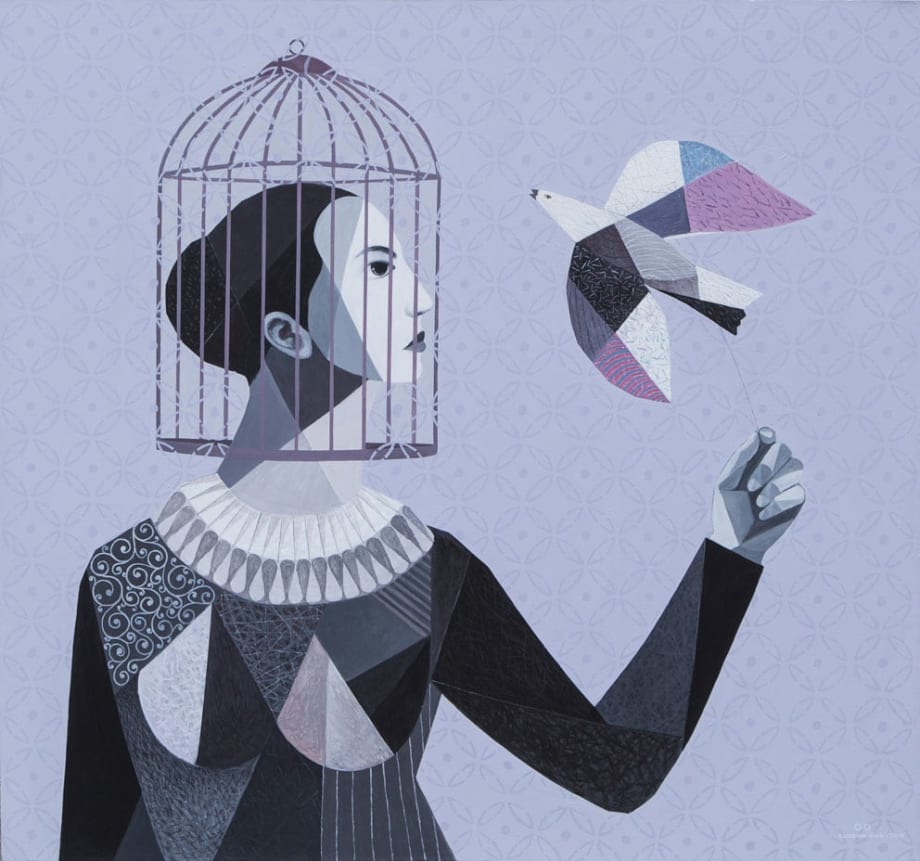Ayyam Gallery Beirut is pleased to present What Happened Here, the solo show of Palestinian-Syrian artist Oussama Diab. Alongside the artist’s latest paintings, the exhibition features selected drawings, mixed-media collages, and preparatory sketches that demonstrate how his new series has progressed with recurring symbols and a cohesive narrative. In recent years Diab has developed a neo-cubist painting style as part of a broader theoretical project that explores the aesthetic potential and relevance of historical precedents. With a postmodern approach, Diab depicts the increasingly fragmentary state of global society as political conflicts tear apart communities, and forced migration and displacement burden the everyday.
Domestic scenes and individual portraits chronicle ordinary life against the backdrop of catastrophic events with the interactions of a couple as the focus of the series. Although his characters are depicted with elegant ornamental patterns that allude to dimension and motion, Diab’s paintings possess a palpable melancholy, as the intimacy of love is now tainted by the shadows of war.
What Happened Here (In the Company of Picasso), the 2015 title work of the exhibition, shows Diab’s male and female protagonists in an updated version of Guernica (1937), the iconic antiwar painting of the Spanish artist. As the central image of the exhibition, the large-scale painting unifies the symbols found in other works such as a wounded dove of peace and a rose signifying hope. The graphic nature of the scene—fractured bodies displayed on tables or pedestals—seems to describe the modern circus of war where devastation and ruin are viewed with the remoteness of still lifes and frozen moments or stationary objects are represented as forms. Diab reduces the chaos of Guernica to a few key figures and transforms its interior space into a series of intersecting planes as though what was once recognisable no longer exists and all that remains are relics of the recent past.
This widespread apathy is further scrutinised in A Daily Scene (2015). Using a Cubist rendering of time in which different views of an object are simultaneously shown, creating a multi-perspective conception of space, Diab details the experience of war by representing its various aspects—death, destruction, defeat, horror, and pessimism—as an assemblage of symbols. A woman’s scream is frozen as a classical bust, her limbless body divided into contrasting areas of light.
Her dismembered arm, previously shown in the painting A Rose for Peace (2015), is placed beside her as a still life detail; the extended appendage holds the flower she once offered to a charging soldier. Her pet dove, her companion in other compositions, is also placed nearby, its fragile body blackened by the onset of death.
About the Artist
Palestinian artist Oussama Diab applies a conceptual approach to painting by exploiting the stylistic variants of the medium as emotive prompts in order to explore how form can articulate the urgency of sociopolitical issues. In an age where digital media have taken a dominate role in filtering our everyday experiences and the (de)construction of images has become integral to the negotiation of modern life, Diab addresses the contradictions and obstacles of political conflict, globalisation, and exile through playful symbolism, references to popular culture, iconic imagery, and narrative driven compositions. With each new series he adopts a different painting style, reflecting the impermanent nature of art as it becomes increasingly conceptual and further dematerialised.
Born in 1977 in Damascus, Oussama Diab lives and works in Beirut. A graduate of the Faculty of Fine Arts in Damascus in 2002, he has featured in solo and group exhibitions throughout the region, and is the recipient of numerous awards including the Shabab Young Artists exhibition in Syria. Solo shows include Ayyam Gallery DIFC, Dubai (2012); Ayyam Gallery Beirut (2010-11); Ayyam Gallery Damascus (2009).

